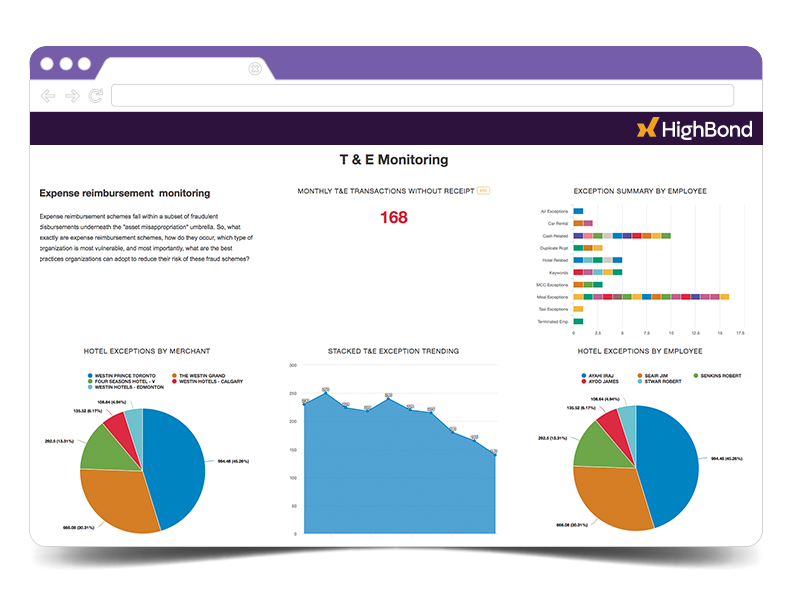Using automated monitoring can free up your resources so you can focus on more strategic tasks and achieve meaningful results faster.
Audit teams in financial institutions have ever-growing functions to manage in a regulatory landscape that’s always changing. They provide assurance over the endless streams of data that the bank or credit union generates, and are responsible for making continuous contributions to the safe and sound running of the financial system.
But often, while trying to wrangle and interpret data, audit teams are constantly bombarded by senior management’s daily demands.This results in you spending your days being more reactive than strategic in your work. Your regular tasks go out the window, and eventually you find yourself struggling to manage the workload.
This is where automated monitoring comes in. By identifying and testing controls with analytics, you’ll automate routine tasks and free up your audit team to:
- Focus their time on the things that matter the most
- Extract the most value out of all that data
- Help your organization make strategic decisions without subjectivity.
Sounds good, right? But where do you start? We put together this outline to guide you.
Designate a central team to focus on analytics
Introducing and implementing automated monitoring is not something that can be built and supported by a part-time worker. You need a dedicated, knowledgeable central team that understands the business, its goals, and its strategy. The first step is to create this team so they can act as the go-to for all business/data-related questions.
Get them to analyze the past six months
Next, you’ll want the team to get familiar with—and take inventory of—all the ad hoc tests, requests, and demands from the past six months. By doing this they can isolate the repeat requests and manual processes to pinpoint the tasks that can be automated.
Strategically review the work
You’ll end up with a laundry list of testing and tasks that would benefit from automation. But before any further work is done, it’s important to review those tests and tasks to make sure they line up with the strategic goals of your departments and the business itself. Keeping this focus will help you:
- Weed out the work that doesn’t add value
- Identify the data and sources needed for the job
- Uncover any gaps in technology and processes.
Implement analytics
This is a somewhat larger, more intensive step than the rest. But if you’ve already got a solution in place it’s much easier to make this leap. If you don’t have a solution in place, what you choose depends on your organization and the needs of your audit team. You’d need to work together with your stakeholders to evaluate and select the right analytics tool.
A solution like ACL Robotics will schedule automated testing and access, normalize, and connect all your data in one single platform. Plus your subscription provides access to to hundreds of pre-built analytics testing ideas you can implement right away.
One example is testing dormant accounts with sudden activity. Using analytics, identify any bank accounts that have suddenly become active after having zero activity for a certain time period. The activity could include a high volume of transactions or other unusual behavior. You can then figure out why this account had not been accessed previously, and if the sudden transactions are valid or if they’re fraudulent.
After choosing the analytic tests, it’s easy to schedule them to run on a regular, recurring basis. Tests are run in exactly the same way every time, so you can trust that the data is always consistent.
By using these easy-to-implement tests and tapping into 100% of your organization’s data, you’ll quickly move from after-the-fact data extractions to predictive, continuous, near-time testing.
Track and report findings
With the program now in play, it’s time to define and track metrics to measure your team’s productivity. Are these automated processes saving time? If so, how much? If not, what can be done to make things more efficient?
Purpose-built software helps by:
- Giving senior management instant access to the results of the continuous monitoring system
- Creating shareable visualizations and storyboards to illustrate how the team is adding value
- Uncovering mistakes and helping find new approaches so the same mistakes aren’t repeated in the future.
Storyboards help illustrate how your team is adding value.
Rinse, review, and repeat
A great thing about automated monitoring is that it can be incrementally built. Once the above steps are completed, it’s good to go back to the beginning to make sure the team is working well, and that they have the right support and tools to be successful.
Finally, get into the habit of constantly asking yourself: Is there something else that should be monitored? Is there anything that can be refined or removed?
“Rome wasn’t built in a day, and an automated monitoring program takes time to perfect. But with each cycle, your system—and your team—will improve.”
Learn more about ACL Robotics
eBook:
Balancing risk & control productivity
You’ll learn:
- How to illuminate risks in finance and accounting systems
- 7 Performance Hacks to improve risk management and performance
- How to understand the gaps in your ERP Systems










